…or rather, the re-new-ed PCC
The Polynesian Cultural Center has been open now for 55 years, and in addition to its age and the routine wear-and-tear from working with many millions of visitors, Hawaii’s beautiful natural environment can also wreak havoc on the Center’s upkeep.
For example, “the “life cycle of air conditioners is pretty short here,” said Jerome Uluave, PCC vice president of Facilities Management (pictured at left in the photo above). Uluave, a Laie native, first worked at the Center as a teenager. After obtaining a degree in construction management and more practical experience, he rejoined the PCC in 2014.
“Our gentle trade winds cool us, but also carry salt spray that can be ‘corrosive’ in the long run; and our tropical climate encourages hungry termites to devour traditional building materials.” Consequently, he continued, “the first thing we always want to do is make sure we take care of what we have, so that our existing facilities last longer than the normal.”
To do this, Uluave shared that about 10% of all PCC employees, including an even higher percentage of senior missionary volunteers, are directly involved in maintaining and improving the facilities.
Using their skills, plus outside contractors when needed, the PCC has recently completed a multi-million-dollar overhaul to almost all our physical facilities over the past decade.
Getting prepared for the second 50-years
David Duffin (pictured at right in the photo at the top), PCC Facilities planning manager who earned a degree in facility and property management from BYU in Utah said that starting about 11 years ago, PCC began planning the years-long round of adding new capital improvements, renovating virtually every major facility at the Center. “The ‘bucket list’ they generated from 2008-2010 has all been completed.”
Duffin and Uluave pointed out a selection of these key projects and improvements — the same changes you might notice, if you haven’t been to the Center for a while, during your next visit to the Polynesian Cultural Center.
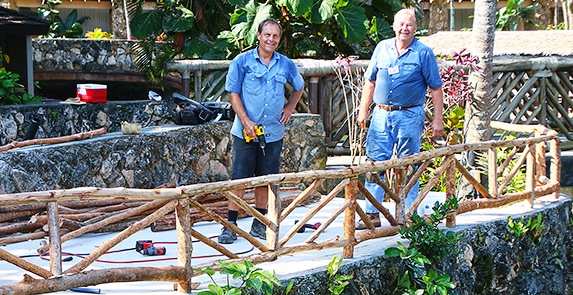
Senior missionaries work hard to update many areas around the Polynesian Cultural Center. Pictured are Elders Green (left) and Nelson. (Photo by Mike Foley
Getting ready for PCC’s new canoe celebration this summer
■ Most recently, for example, the PCC added a deck by the lagoon, near the Hale Ohana luau venue and Hawaiian Mission Home Settlement, that seats about 900 guests. Their view will be perfect when the Center’s new canoe celebration, “Huki” premiers this coming summer (more info to come on this exciting development).
Duffin said it took the PCC “blue-shirt team” about three-plus months to build the deck, designed by a senior volunteer missionary who previously worked in that business. When a moth infestation affected the normal supply of Hawaiian ohi’a logs from the Big Island, the Center substituted ironwood rails from nearby Kahuku.
“We’ve had a lot of good senior missionary volunteers helping us,” said Uluave.
Behind the scenes…
■ Meanwhile “behind the scenes,” the senior volunteers have created eight new fiberglass molds for the new production’s canoes, and revamped the carvers shop. Nearby, original PCC labor missionary and long-time master carver Sione Tuione Pulotu is busy creating drums for Huki drummers
■ A combination of contractors and PCC “blue shirts” recently reroofed the PCC employee building, which houses laundry and costume seamstress operations, along with the Center’s large central kitchen; and they redid the exterior of the training building and fixed several drainage issues.
Balancing and improving human resources…
Duffin explained using in-house people vs. contractors “is generally a question of resources. Any time we use in-house workers, we’re sacrificing something in terms of maintenance and preventative maintenance. So, we’re careful when we calculate those on the planning side, and we’re getting better and better at it.”
Duffin is also involved in upgrading the in-house staff through National Center for Construction Education & Research (NCCER) training, a nationally accredited trade-specific training and certification program. “We use our skilled senior missionaries as master trainers to teach our men.”
“We’re actually a certified NCCER location,” Uluave added. “This is one of the ways we allow our people to grow and provide them with opportunities they wouldn’t otherwise be able to afford.”
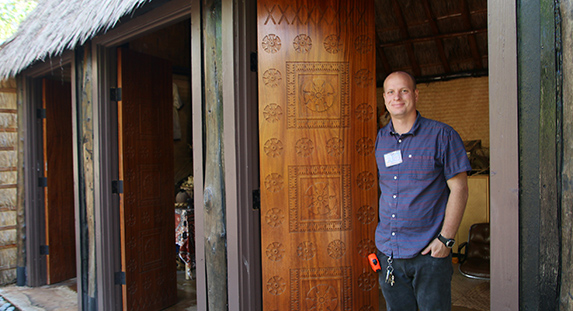
David Duffin, Facilities Planning Manager at the Polynesian Cultural Center shows the beautifully machine milled wooden doors in the Fijian Village. The Center recently acquired milling equipment from the estate of a former Sunset Beach man.
In the public eye…
The PCC has completed a number of large capital improvement projects as part of the overhaul:
■ The 24,500 square-foot Gateway dining and multipurpose venue was one of the earliest facilities the PCC renovated. On Nov. 11, 2011, hundreds of VIPs, industry leaders and other special guests attended the grand opening ceremonies, and for the first time saw its magnificent 5,000-plus square-foot mural sequences — one of the largest in the world — and huge Polynesian design elements.
In addition to the hundreds-of-thousands of meals served there on a daily basis, the PCC’s Gateway — originally opened about 40 years ago — has also hosted concerts, royal receptions, employee and community meetings, and even our 50th anniversary ball.
■ During the PCC’s golden jubilee celebration in 2013, we completed the complete renovation of our large-format media center into the Hawaiian Journey Theater — turning the design motif into a volcano, and premiered our own 15-minute media experience, Hawaiian Journey, on March 29 that year. The film portrays the deep feelings of native Hawaiians to their ancestral islands with stunning imagery
“That was a big project,” Duffin said, noting that in addition to the extensive exterior changes to the building, the inside of the theater got all-new digital audio and visual equipment as well as special seats that enhance the Hawaiian Journey experience.
■ The PCC partnered with the Polynesian Football Hall of Fame in 2014 to create the permanent PFHOF museum display in the Welcome Center, opposite the Gateway venue. Each January since the PCC and PFHOF participate in an annual enshrinement program in Laie. Tongan architect Norman Harris designed the museum. Each January the PCC and PFHOF participate in an annual enshrinement program in Laie. As with other features of the Hukilau Marketplace, admission is free.
■ The recent free-admission Hukilau Marketplace has been a big hit since it opened to the public on Feb. 20, 2015, after several years of extensive work. Its more than 40 shops, eating and entertainment options have become popular with visitors, community residents and kamaaina [Hawaii residents] ever since.P
■ In March 2016 the PCC finished a complete makeover of our Mahinalani Gift Shop on the edge of the Hukilau Marketplace, which included adding the Ukulele Experience, where guests can see how ukulele are made, and even take a free ukulele lesson.
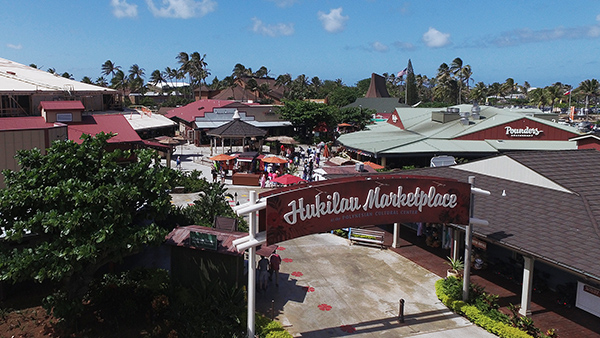
Aerial photo of the popular Hukilau Marketplace now at the entrance to the Polynesian Cultural Center.
And in the villages…
“We’ve ‘touched’ every village and rehabbed them since the projects began,” Duffin continued. Some of the specifics include:
■ The Hawaiian Village got a complete facelift in timed for the PCC’s 50th anniversary in 2013 and held grand opening ceremonies on March 29th. Recent new additions include the permanent hale wa’a [canoe house] for BYU-Hawaii’s 57-foot Iosepa, a traditional twin-hulled sailing canoe that capable of traveling interisland — and does, from time to time.
■ Also in 2013, the PCC completely refurbished the Islands of Aotearoa, bringing back Taka Walker from New Zealand, the last surviving member of the carvers team which created the original panels in the Maori Village.
Duffin also pointed out that they rebuilt the tititorea [Maori stick game] hut, added new sidewalks, improved drainage, and reinstalled the magnificent 40-man waka taua [war canoe], which Center carvers have completely restored. In addition, Uluave noted the Maori carvers building has also been remodeled, and will reopen in approximately one month.
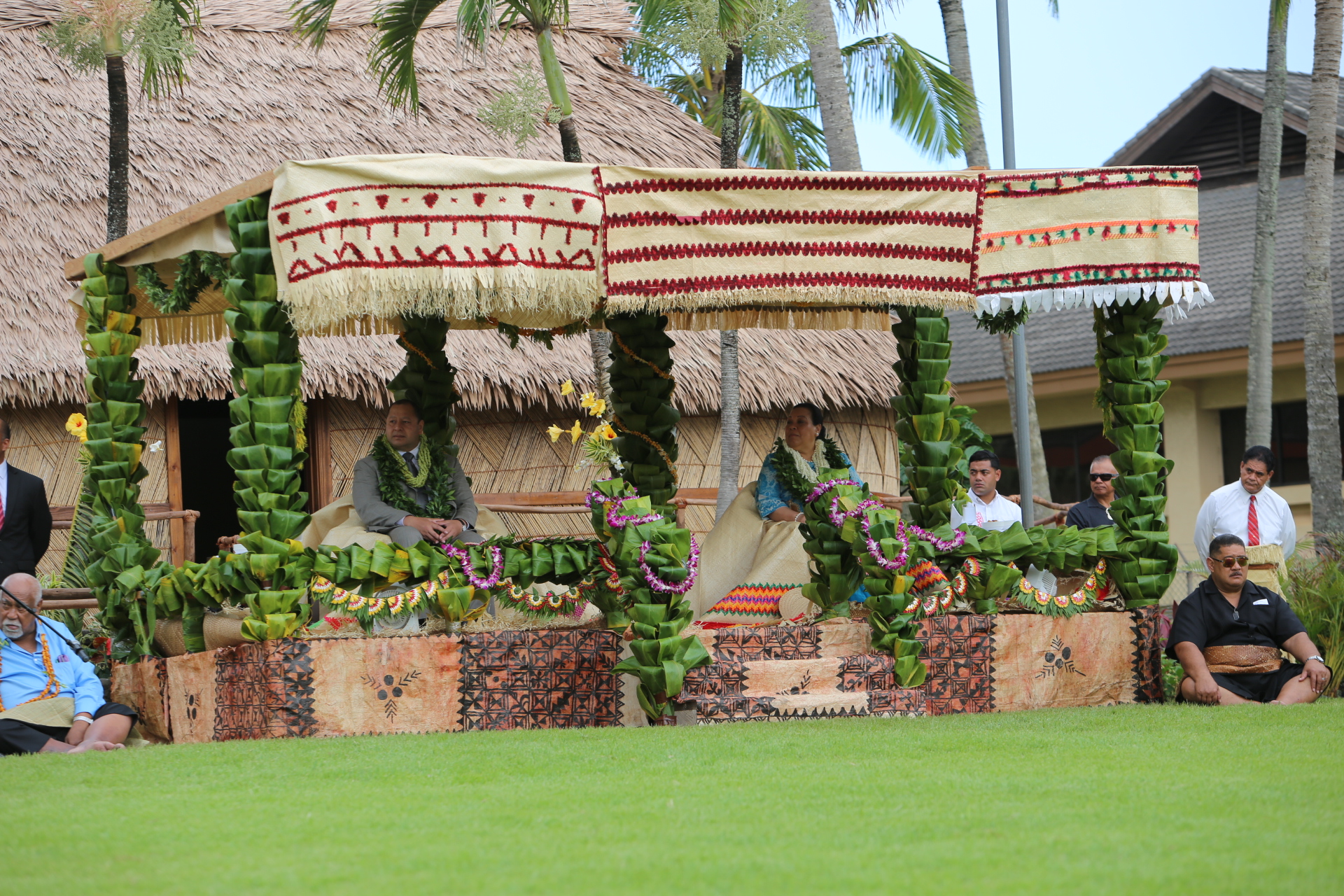
The king and queen of Tonga in front of the quarter-scale replica of the late Queen Salote’s summer palace at the Polynesian Cultural Center.
■ In perhaps one of the most celebrated facelifts, the current king and queen of Tonga came to the Polynesian Cultural Center on June 10-11, 2016, to “reign” over the grand reopening of the Tongan Village. Of couse, that visit meant lots of Polynesian protocol for HM King Tupou VI and HM Queen Nanasi Pau’u.
In one of the more subtle changes to the Tongan Village facilities, Uluave pointed out that PCC crews dismantled the replica of the late Queen Salote’s summer palace, which she originally authorized for the Center in 1962, so they could raise height of the paepae or foundation, thus appropriately lifting the unique building higher than all other structures in the village.
■ Uluave also said the PCC has most recently completed renovating the Fijian Village.
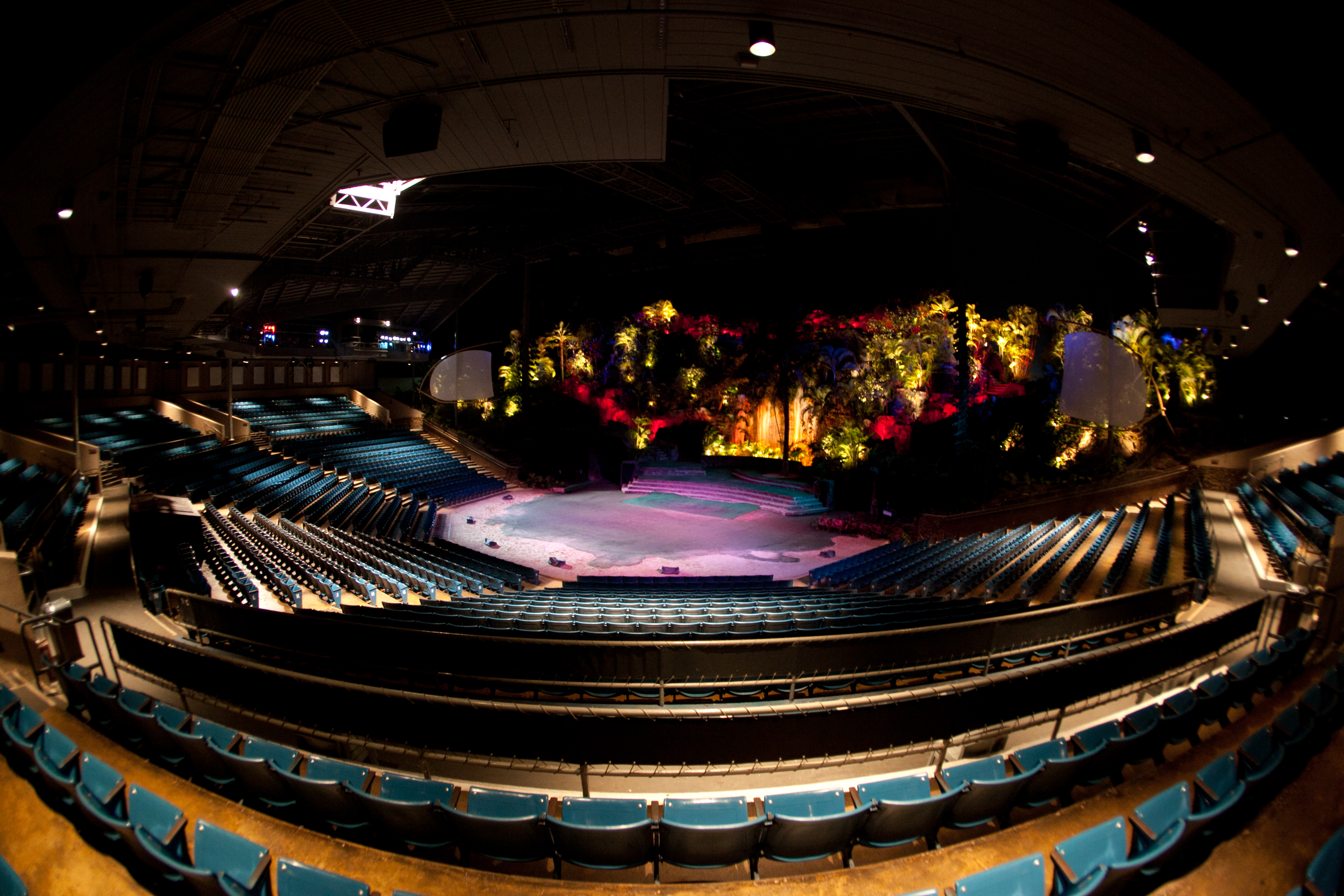
Restoration projects at the Pacific Theater, which hosts Ha: The Breath of Life, have been very successful.
And still more…
■ When electrical power to the PCC is interrupted, guests are usually not even aware of an outage. This is because one of the overhaul projects included adding a 2 megawatt generator with automatic switching capabilities several years ago.
■ In 2017 PCC made structural improvements to the 2,700-seat Pacific Theater, “and we’re currently redoing the Pacific Theater roof,” Uluave said. He added this does not include the many theater technology changes recently made for the PCC’s world-famous evening show, Ha: Breath of Life; “and next year, we’re going to work on the ‘mountain’ [four-story volcano backdrop].”
Looking forward…
Future projects already slated include increasing the number of solar panels at the PCC, as well as expanding the capabilities of the Center’s nursery, which currently covers seven acres.
Duffin shared that PCC continues to work on future master planning. “I think we’ve made a lot of progress, not just ticking projects off a list, but also in developing relationships all around and getting better at what we do.
“I love our team, but I’m never satisfied,” Uluave said. “I’m glad I came back. I love the company. Our group is always looking to improve. It’s good to be a part of a group that’s progressive, and we have fun while we do it.”

Story and photos by Mike Foley, who has been a full-time freelance writer and digital media specialist since 2002. Prior to that he had a long career in marketing communications, PR, journalism and university education. Foley learned to speak fluent Samoan as a Mormon missionary before moving to Laie in 1967 — and still does. He has traveled extensively over the years throughout Polynesia, other Pacific islands and Asia. He is mostly retired now, but continues to contribute to PCC and various other media.
When he was a student worker at the Center in the 1960s, Foley recalls the maintenance shop was the size of a car garage.

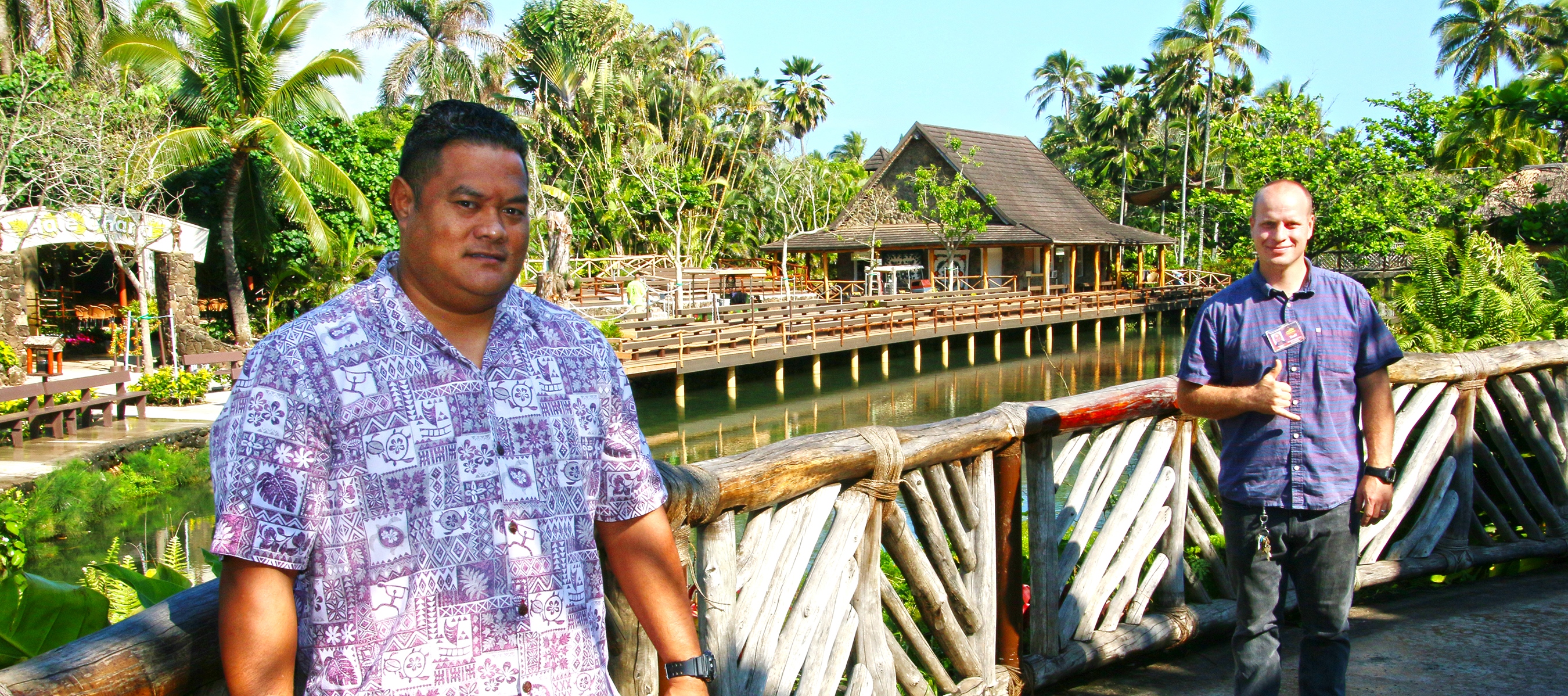
We truly miss the eighteen months we served at the Mission Settlement Home. We were blessed to have such great couples to work with.
The people of the Polynesian Cultural Center awaits your return.
We love Hawaii and the PCC and will be returning next month for another visit (from So Cal)! We also love the Ukulele Experience. We’re so glad that so much love goes into the Center and its offerings!
Mahalo. We are so glad that you love the Polynesian Cultural Center as much as we do. The Ukulele Experience is such a fun store and the walk-thru museum showcasing how ukuleles are made is a special addition. We try very hard to honor the beautiful Polynesian culture and are very happy you are returning soon.
I think there is a typo in the caption for the picture of the Tongan King and Queens’s replica palace:
CAPTION: The king and queen of Tonga in front of the quarter-scale replica of the late Queen Salote’s summer placer at the Polynesian Cultural Center.
(SHOULD BE “palace”, not “placer”, right?)
Thanks for the heads up! We have it fixed.
I read this article for specific mention of the Lagoon…didn’t find anything.
We have fond memories from 1998 as senior missionaries helping to clean the lagoon, section by section, working from early morning and getting bridges etc. back in place by 12 o’clock each day for the guests to start arriving. My husband, elder Woody Sandberg, left a supervisory report of the cleaning project and possible ideas for the future.
Oh how we enjoyed our time at PCC, and how we loved the people. We are sending every wish and prayer for continuing success and improvement.
We send our aloha from StGeorge, Utah..
Mahalo for sharing your memories. We would love to have you come back to see how beautiful the lagoon is now. The waters are clear, the bridges have been refreshed with new senet and are sturdy and strong. We have coy and tilapia thriving and our waterway to the ocean are kept clear as the blue shirts work hard to keep the debris clear. There are some other changes, such as landings, AND we are looking at a new guided tour soon!